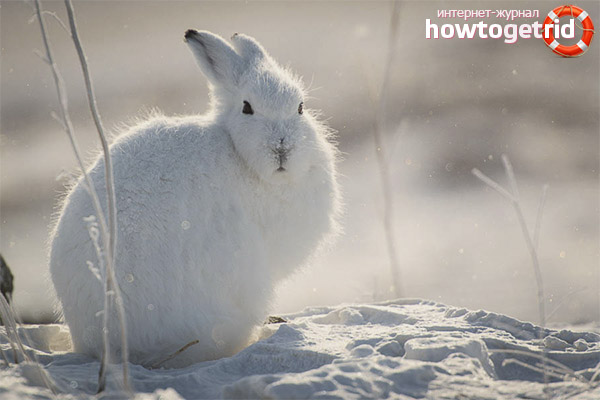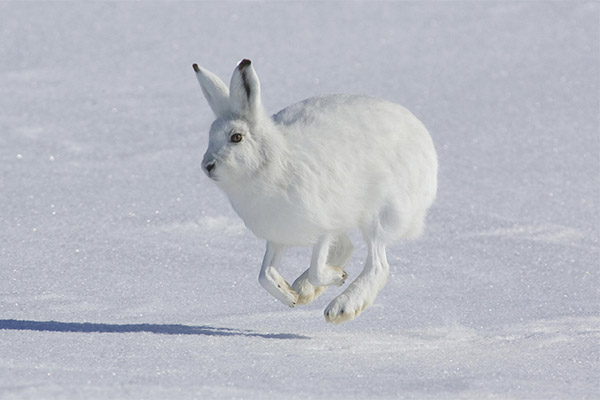The content of the article
- 1 Appearance subspecies hare white hare
- 2 White hare behavior in everyday life
- 3 Specific nutrition hare white hare
- 4 Breed hare
- 5 White hare habitat
- 6 White hare population and factors affecting it
- 7 White hare protection
- 8 White hare and man
- 9 The effect of the white hare on the ecological state of nature
- 10 Video: white hare (Lepus timidus)
White hare from lat. Lepustimidus - an animal mammal, belongs to the order of lagomorphs.
Appearance subspecies hare white hare
This subspecies has paws, large in width, completely covered with thick fur. The body weight of the animal can reach 4.5-5 kg. The length of the ears reaches 10 cm. The small rounded tail is about 6.5 cm.
The color of the hare changes with the change of the season, the coat is gray in summer, sometimes with a touch of red. And in winter - snow-white, with barely noticeable dark patches on the ears. The hare sheds twice a year, this process occurs depending on the temperature conditions in the habitat. On the territory where snow falls there is much less, the color of the animal remains grayish.
White hare behavior in everyday life
With sufficient food supplies, the hare will be able to overcome up to 9-10 km in one night, in the opposite situation they will not even master three kilometers. An amazing fact: the white hare has time to knock on the ground with its paws before retiring from its place. Thus, he signals his approach of danger. Entangling the tracks, the white hare jumps five meters ahead, and then abruptly to the side.
Specific nutrition hare white hare
The animal belongs to the herbivorous representatives. In the summer, food includes green plants such as clover, leaves that are found in habitable areas.
In winter it is much more difficult to find food. During this period, the bark of the tree comes into play, birch or aspen will approach, as well as branches of dry bushes. The bumps found in the snow or dry grass serve as food.
Breed hare
Spring and summer periods are considered the most suitable for mating. Usually up to seven babies are born. During the season there are from two to four broods of offspring. The gestation period of the female hare lasts about 50 days. Hares come into the world with open eyes and can already move themselves. Females, oddly enough, feed not only their offspring, but also accidentally found cubs are hares, because from the accumulated milk in the glands, the instinct induces the hares to be freed from its excess.
When a man appears on the horizon, the female hare distracts him from her offspring, pretending to be wounded, tries to attract attention by tapping on the ground with her paws. The male white does not take part in caring for brood, but in turn does not interfere and does not bring trouble.
At two weeks of age, the hares begin to independently eat grass, stalks and leaves of green plants.The first eight days the offspring feeds exclusively on mother's milk, and then the babies go on a regular diet. After reaching two and a half weeks, babies become independent, and at the age of ten months are ready for sexual activity. Life expectancy of hares is in most cases 17 years old.
White hare habitat

Like the hare of a hare, the habitats of this species are very diverse. Belyak looks after the terrain for living near the land where you can always find food, despite the season. This place can be the edge of mixed forests or bush thickets. Also, the hare is concealed in the high grass, sometimes in the reeds near the water - there it will be out of reach for the enemies.
In the white hare, the most developed sense organ is a rumor that promptly warns it of the approach of a predator or any other calamity. Sight and smell are much weaker, and if a person stands nearby, even on empty terrain a white hare can sometimes come close enough. In fact, the only protective measure against the pursuer is the ability to quickly run away. Interestingly, the haunted hare, only a little away from the pursuit, makes clever tricks.Over the course of evolution, hares have learned to move away from predators with the help of incredible dexterity, cunning, and flawless camouflage. Running speed can be compared to the speed of a traveling car, and this is 50-60 km / h. With all of this, without lowering the pace, they can make sharp turns, forcing the enemy to slow down to re-make clever reception.
White hare population and factors affecting it
The population of this species of hares is located in especially the northern regions, the forests of northwestern Europe (Switzerland, Norway, Scandinavia), in North America, in the part of Russia close to Europe, in the tundra zone, on Sakhalin.
The hare's sworn enemies are such animals as wolverine, marten, but mostly - fox. In winter, hares fall into the hands of predators more often than in summer. Large birds of prey attack them, such as white-tailed eagles. Although the hares have a sufficient number of enemies, but all of them do not feed exclusively on hares, the possible reason for this phenomenon is that their numbers are not too large. It is proved from the findings of their remains that most white hares die from attacks by predators and rarely live to old age.
In past centuries, hares were hunted extremely rarely, most often they were found by chance, as the partridges were chased. People of the older generation did not eat hares because of their religious beliefs, which attributed the hare, bear and squirrel to “dirty” animals, their consumption was not welcomed. In order to make fur blanks, hares were also not popular.
In general, the number of white hare is exposed to many phenomena that affect its population.
White hare protection
In our time, white hair is an important goal of the sport hunting and fur industry. It is mined in large quantities for food and skin.
During the construction and construction of roads and highways, as well as the reconstruction of other linear communications crossing forest and adjacent territories, devices with special aisles are provided for the safe movement of wild animals along them.
White hare and man
Usually hares live near the person.
Sometimes the population of a species is rapidly decreasing as a result of various epidemics. And in the grace years, the number increases dramatically. Bursts of such phenomena occur, as a rule, once in 12 years.
The constant harm that white hair brings in farms and farms is quite small and does not have a particular impact on the economic activities of people. But over time, cases of infection of people during periods of hunting with diseases carried by white hares have become more frequent, such as tularemia.
The effect of the white hare on the ecological state of nature
The white hare is a simple subspecies that easily adapts to a nearby person. Over time, the population changes tens or even hundreds of times. The main reason for the extinction of the number of heads are the epizootics, which are a consequence of the “harvest” of these hares. The nature of this phenomenon is rarely obtained. There have been cases of numerous deaths of hares of this breed from parasites of worms, of which nematodes (roundworms), living usually in light animals, are especially dangerous. Intestinal diseases are also frequent.In times of high white hare populations, the number of predatory animals hunting them: foxes, golden eagles, and eagle owls increases.
Video: white hare (Lepus timidus)












To send